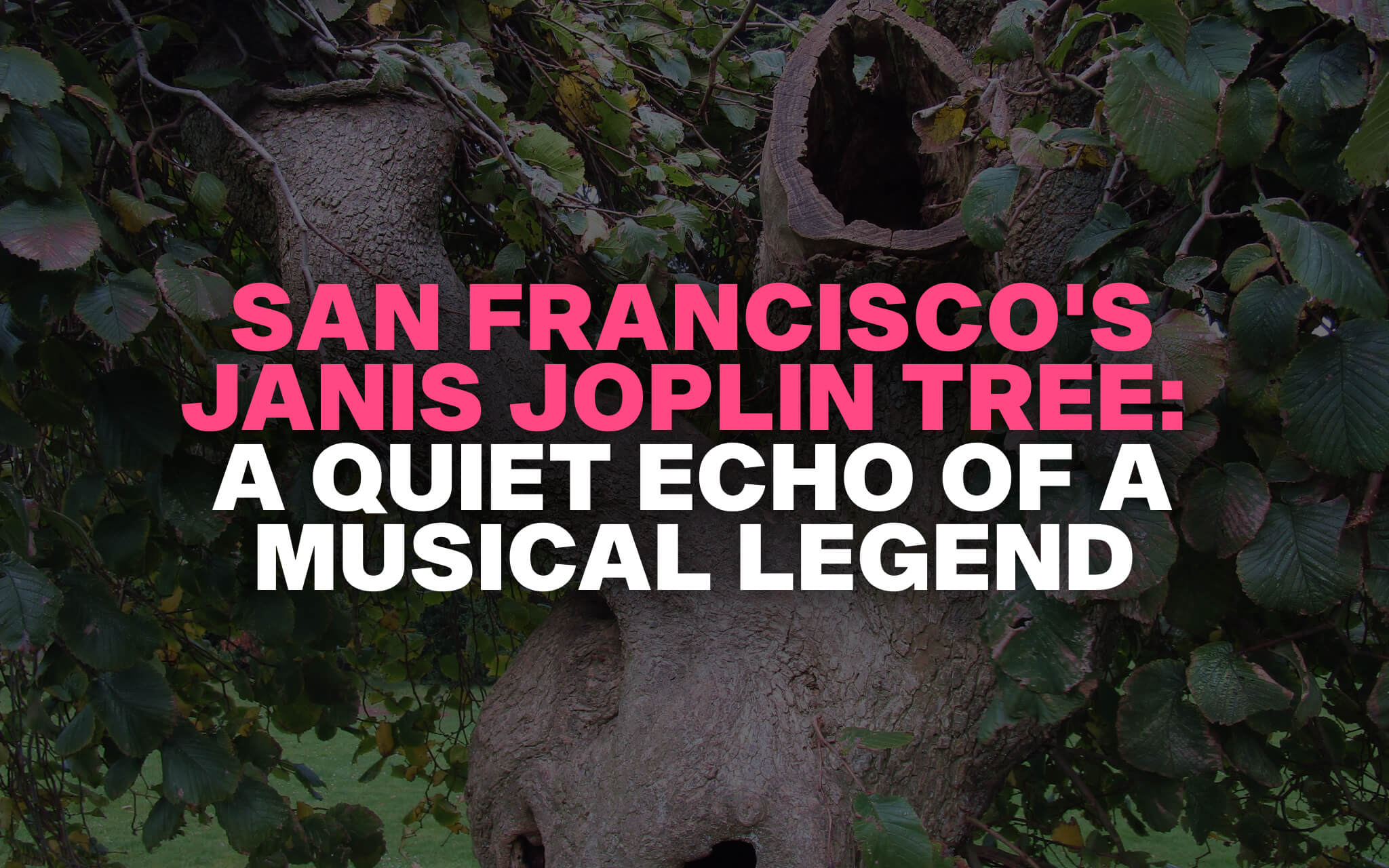
If you walk the grassy rise of Hippie Hill, you’ll find more than shade beneath the Janis Joplin Tree—you’ll find a story rooted in San Francisco’s musical soul. This unassuming elm, located at the base of Hippie Hill in Golden Gate Park, was a favored spot for Janis Joplin during the 1960s. Here, she would often sit with her guitar, her soulful voice resonating through the park, captivating audiences both large and small. The tree has since become a pilgrimage site for fans, symbolizing the enduring legacy of Janis Joplin’s music and the counterculture movement she epitomized.
Hippie Hill, nestled between the Conservatory of Flowers and Haight Street, was a central gathering place during the Summer of Love in 1967. Its gentle slopes and open spaces provided the perfect backdrop for spontaneous musical performances, communal activities, and the free-spirited ethos that defined the era. The Janis Joplin Tree, in particular, holds a special place in this history, marking the very spot where Joplin’s impromptu concerts added to the park’s vibrant atmosphere. Visitors today can sit beneath its branches and imagine the soulful melodies that once filled the air.
The tree itself is a mature elm, its sturdy branches offering ample shade and a sense of tranquility amidst the bustling park. Over the years, it has become a symbolic landmark, drawing music enthusiasts, historians, and tourists alike. While the park does not feature official signage marking the tree, its location at the foot of Hippie Hill makes it relatively easy to find for those seeking to connect with a piece of San Francisco’s musical past.
San Francisco’s Golden Gate Park, spanning over 1,000 acres, is a sprawling urban oasis offering a myriad of attractions. Hippie Hill is situated east of the park’s tennis courts, just off Kezar Drive, overlooking what is now known as Robin Williams Meadow. This area is easily accessible from Haight Street, making it a convenient stop for those exploring San Francisco’s historic Haight-Ashbury district. The park’s layout encourages leisurely strolls, with pathways leading visitors through lush landscapes and past other notable sites.
The proximity of the Janis Joplin Tree to Haight Street adds to its allure. During the 1960s, Haight-Ashbury was the epicenter of the counterculture movement, attracting artists, musicians, and free thinkers from all over the world. Today, the neighborhood retains much of its bohemian charm, with vintage shops, record stores, and murals paying homage to its storied past. Visiting the tree offers a tangible connection to this transformative period in San Francisco’s history.
For those planning a visit, it’s worth noting that Golden Gate Park is open daily, and there is no admission fee. The park is well-served by San Francisco public transportation, and parking is available in the surrounding areas, though it can be limited on weekends and during events. The Janis Joplin Tree provides a serene spot to relax and reflect, offering a respite from the city’s hustle and a chance to immerse oneself in a pivotal piece of musical heritage.
Visitors to the Janis Joplin Tree can expect a peaceful environment, with the gentle rustling of leaves and the occasional distant sound of a drum circle—a nod to the park’s enduring musical traditions. The tree’s expansive canopy offers a cool retreat on warm days, and its branches have been known to cradle the occasional tribute left by admirers. The surrounding lawn provides ample space for picnics, meditation, or simply soaking in the ambiance of this historic locale.
Photography enthusiasts will find the Janis Joplin Tree and its environs particularly inspiring. The interplay of light filtering through the leaves, combined with the historic resonance of the location, provides a compelling subject. Capturing images here not only preserves personal memories but also pays homage to the countless moments of artistic expression that have unfolded beneath its branches.
While immersing oneself in the rich musical history of San Francisco, another captivating experience awaits just a short distance away. The Museum of 3D Illusions offers an interactive adventure that delights visitors of all ages. Located at 55-61 Jefferson Street, this museum features over 40 mind-bending exhibits designed to challenge perceptions and ignite the imagination. From posing atop a magic carpet soaring over the Golden Gate Bridge to escaping the jaws of a giant shark, the museum provides endless opportunities for creative photography and immersive fun.
One of the museum’s standout attractions is “Smash It!”—an activity that invites participants to release pent-up energy by smashing plates in a safe and controlled environment. Guests can write down their stressors or negative thoughts on ceramic plates before hurling them against a wall, symbolically shattering their worries. This cathartic experience has garnered popularity for its unique approach to stress relief and self-expression.
The Museum of 3D Illusions seamlessly blends art and entertainment, making it a must-visit destination for those seeking a break from the ordinary. Its proximity to other iconic San Francisco attractions ensures that visitors can easily incorporate it into a day of exploration. Whether marveling at the illusions or engaging in the liberating act of smashing plates, guests are guaranteed an unforgettable experience that complements the city’s rich tapestry of cultural offerings.
FAQ
Is there anything else to see nearby after visiting the Tree?
Yes, after visiting the Janis Joplin Tree, many visitors explore other San Francisco attractions. One standout is the Museum of 3D Illusions, which offers interactive art experiences just a short drive away. It's a great way to continue your San Francisco adventure after reflecting at the Tree.
Can I take photos at both the Janis Joplin Tree and the Museum of 3D Illusions?
Absolutely. Visitors frequently photograph the Janis Joplin Tree to commemorate their visit to this iconic San Francisco site. The Museum of 3D Illusions encourages photography as part of the immersive experience, making it a perfect addition to your visual tour of Janis Joplin’s cultural legacy.


